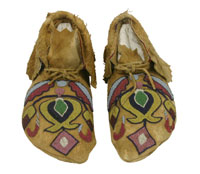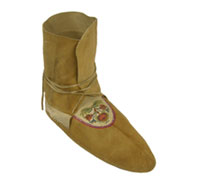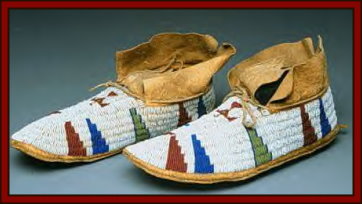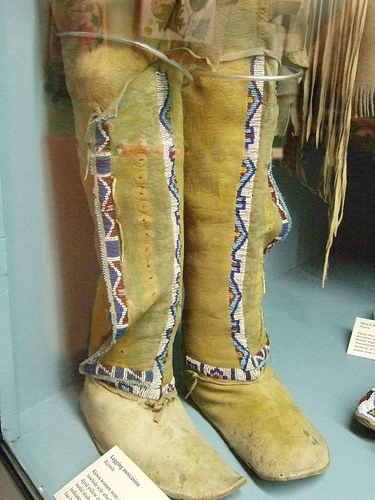Moccasin
| This article may require cleanup. The specific problem is: information is pasted from external source. Relevant discussion may be found on the talk page. Please help improve this article if you can. (April 2016) |
Moccasins, (low tailored shoes), are one type of traditional North American footwear. Woven sandals, boots, and leggings attached to shoes have also been produced by Native Americans. The origins of moccasins go back to the cold, harsh climates of man's past that made it necessary to make protective footwear. Wearing moccasins or boots would have been essential to keep feet from freezing. In warm weather and mild surroundings, protective footwear would be less important and people could easily go barefoot. The word moccasin, which has language origins with Eastern North American tribes, traditionally referred to a shoe with a puckered u-shaped 'vamp' over the instep. The name of the Great Lakes Ojibway tribe means 'people of the puckered moccasin'. The southern New England Narragansett word for shoe is 'Mocussinass' or 'Mockussinchass'. Today the word moccasin, still with innumerable spellings, generally refers to all types of hard and soft soled shoes, with and without puckered toes.
Native American moccasins were designed for their specific environment. Hard-sole moccasins, usually made from two or more pieces of hide, are often associated with the western plains and deserts areas. The hard sole of shaped rawhide and fitted leather upper required more tailoring than other moccasin varieties. Hard-soled moccasins were important to protect feet from harsh cactus or prairie-grass covered ground, and sharp rocks not worn down by water. The turned up toe of many two-piece moccasins (like that of the Apache) prevented sharp objects from running into the seams and injuring the foot. Soft-soled moccasins, often constructed from a single piece of leather were common in the Eastern Forests and were made by bringing up the sole of the shoe around the foot and puckering or patching the material around the instep. Soft-soled center seam and pucker-toe moccasins were well suited to travel through woodlands with leaf and pine-needle covered ground. Some soft-soled moccasins from the Plains and Northwest Coast were made from one piece but they were sewed along one the side of the foot rather than the center.
The most basic form of soft-sole moccasin was the simple center seam made from a single piece of tanned leather. The leather sides were brought up from the bottom and around the sides of the foot sewn in a central seam starting with a puckered stitch at the toe and running along the upper instep. Variations of soft-sole moccasin construction include a u-shaped piece of leather, added as a vamp, while another piece was added to the back of the moccasin to serve as a cuff. Some of the Great Lakes and Iroquois tribes used a wide vamp, added in a gathered fashion to cover most of the upper front of the moccasin. Other Eastern Forest tribes made moccasins with a shorter or narrower vamp that sometimes joined a central puckered seam running down the upper front to the toe.
Moccasins were made with all types of variations and additions according to the styles of different tribes. So distinctive are some moccasin styles that one could tell the tribe of the wearer by his footprints. Flaps of leather or fur were often added to cover the ankle, or folded down as a cuff. Some moccasins were made into a boot simply by attaching them to the leggings. Various sized u-shaped or elliptical pieces of leather, called vamps or insets, were added to the moccasin upper at the instep. A tongue for hard and soft-soled moccasins was often added and cut into various forms and decorated. Many methods were used to pucker the toes of woodland center-seam moccasins. A distinctive 'rabbit nose' or 'partridge' moccasins could be sewed by trimming the pattern first into a 'w' shape. There were also many ways to finish the heels of moccasins. Varieties of Eastern Woodland moccasins often left a tiny tab, or tail, trimmed to different shapes, that dragged behind. Other one-piece moccasins have no tail, or the tab is sewn up to the heel for added reinforcement. Some moccasins of the plains and prairie had fringe hanging at the heel seam or added onto the instep; as fringe trailed behind the walker, it may have helped to obliterate footprints.
Materials
Moccasins were usually made from the soft tanned hides of deer, moose, elk or buffalo. Rawhide was used for the hard-soled moccasins. Hides from the larger animals were much thicker than buckskin. Thicker hides were more difficult to sew, but produced sturdier, longer lasting moccasins. Sewing is easier with soft Indian-tanned (or brain-tanned) leather, but commercially sueded and split leather is also suitable for moccasin making. Commercial leather is most like brain tanned leather when it is split (sueded on both sides), as the smooth outside of the hide has been split off. The thickness of commercial leather is measured by the weight in ounces of a square foot of leather. Very thin garment leathers, 1-2 oz. weight, is usually too thin for practical moccasins, while heavy leathers, 5-6 oz. weight, can be nearly impossible to sew by hand. Medium thickness leather (3-4 oz. weight) is recommended for most soft-soled moccasins. Patterns should be laid out on the hide so the pieces go with the grain of the leather, so the moccasins will be uniform. If conservation of leather is a consideration, pieces can be laid out so leather is not wasted, but as the leather stretches in different directions, sewing can become a little irregular.
Construction
Moccasins were assembled inside out to hide the stitching in the finished shoe. Stitching would be done traditionally with sinew through holes punched with an bone awl. For comfort, knots were kept on the outside of a shoe. The whip stitch was commonly used in moccasins, often with an added narrow welt running the length of the seam to make the moccasin stronger and to help hide the stitching when turned right side out. The running stitch was also used in places where the whip stitch was not as practical, as with added fringe. Seams were often gently pounded flat in puckered areas.
Even though moccasin construction techniques are similar among many tribes, the beaded or quilled decorations were often quite distinctive. Woodland moccasins were often decorated, usually in floral or zoomorphic designs, on the instep or tongue portion, woodland decorationdid not usually cover the sides of the moccasin. The flap or added cuff around the ankle was also often decorated, or worn upright and held in place by thongs wrapped around the ankle. A separate beaded or quilled piece of velvet or leather was sometimes sewn on top of the cuff or tongue portion. These decorated panels could be easily removed from the moccasins when the soles wore out, and sewn onto a new pair. Plains moccasins often left the cuff undecorated, but geometric bead and quillwork patterns often decorated the instep portion, or around the circumference near the sole. Some Plains designs covered the entire top of the moccasin from the heel to the toe. Moccasins worn for marraige were often completely covered in beads. For Plains peoples preparedness in the afterlife, many moccasins worn into burial were fully beaded even on the bottom of the soles.



